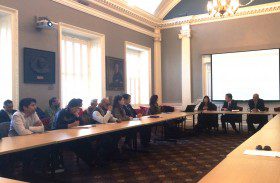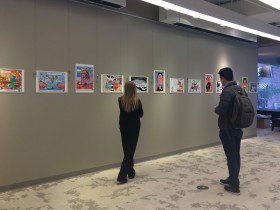 The Indo-US relationship is not just defined by economic investment or a military partnership; it is increasingly becoming a combined strategic view.
The Indo-US relationship is not just defined by economic investment or a military partnership; it is increasingly becoming a combined strategic view.
By Ghazal Gulati, Ed. M Candidate, International Education Policy, Harvard Graduate School of Education (@GhazalGulati)
On March 25, 2015, the South Asia Institute hosted a special event at the Harvard Graduate School of Education about Indo-US relations. The event marked the culmination of “The Political Pickle: An Exhibition of Editorial Cartoons and Caricatures on India and the United States, ” by Shreyas Navare, Fellow, Weatherhead Center for International Affairs and Editorial Cartoonist, Hindustan Times, India.
Click here to see Navare’s political cartoons.
Tanvi Madan, PhD Fellow, Foreign Policy Director, The India Project, The Brookings Institution, and Shivshankar Menon, Former National Security Advisor and Foreign Secretary, India, were the speakers. The event was chaired by Nicholas Burns, Sultan of Oman Professor of the Practice of International Relations, Harvard Kennedy School.
The conversation began with Madan laying out a comprehensive history of the Indo-US relationship, from the first presidential visit in 1949 to Obama’s recent visit on the occasion of India’s Republic Day parade in January. The Indo-US engagement has been consistent, continuing and increasing over the last several decades. This is evidenced by increased defense trade between the nations, improved revenue from travel remittances, and a large number of sectors outlined for collaboration.
Madan described the strategic importance of India as a partner to the United States due to its geographic location as well as its flourishing economy. The United States does not view a strong, rising India as a threat, but rather as a potential strategic partner, according to Madan. However, she clearly warned of the constantly changing perception of this relationship. Many wrote it off last year while hailing its re-emergence this year.
Shivshankar Menon brought to the discussion his wealth of his experience in the Indian foreign service. Like Madan, he was very optimistic about the current state of the relationship between the two countries.
He gave several reasons for the importance placed by the Indian government on a healthy partnership with the U.S. With growing globalization, fifty percent of India’s GDP is linked to other nations. To transform its economy, India looks to the United States for knowledge, energy, and much more. Menon was very confident that with India’s development, the strength of this relationship will continue to grow. This mutual interest is a signal by both countries of common will and alignment.
However, he cautioned the audience that both countries should not become victims of their own success, as expectations around this relationship are extremely high. Similar to Madan, Menon was convinced that a lot of hard work is needed to truly nurture this relationship.
Professor Burns, a former US diplomat, and Menon shared anecdotes of their time spent negotiating issues between India and the U.S, including the Civil Nuclear Deal. The discussion was a great opportunity for the audience to learn about the world of international diplomacy.
An interesting insight that this conversation revealed was that the mutual understanding of the US-India relationship is as a strategic alignment, and not a formal treaty partnership. India continues to trade with and partner with several nations in the world including China. To preserve the independence of its actions and views, both governments have stayed away from formalizing this partnership.
Yet, all three speakers agreed that the US relationship is very different from India’s partnerships with other nations. This is due to the strong ties that many Indians have who are living in the US, increasing the links between the two nations. According to all three speakers, The “de-hyphenation” of India and Pakistan for diplomatic talks during the Bush administration pushed the momentum forward for an India-specific strategy by the United States, separate from Pakistan. Madan noted that the fact that Pakistan was discussed very little during the event was an indication of a significant shift.
The event ended with an engaging Q&A session with the audience. The responses revealed more in-depth details of the Indo-US relations. For example, Professor Burns noted that the US views Kashmir as a bilateral issue between India and Pakistan. Menon pointed out that obtaining a permanent seat in the UN Security Council was more complex than just obtaining the support of the U.S.
The event was followed by a reception of political cartoons at the Gutman Library.
‘A US-India comeback?’ by Nicholas Burns – The Boston Globe
This event was sponsored by Cosponsored by the Weatherhead Center for International Affairs and the WCFIA Fellows Program. Supported by the Hindustan Times and the South Asian Art Council – Boston

